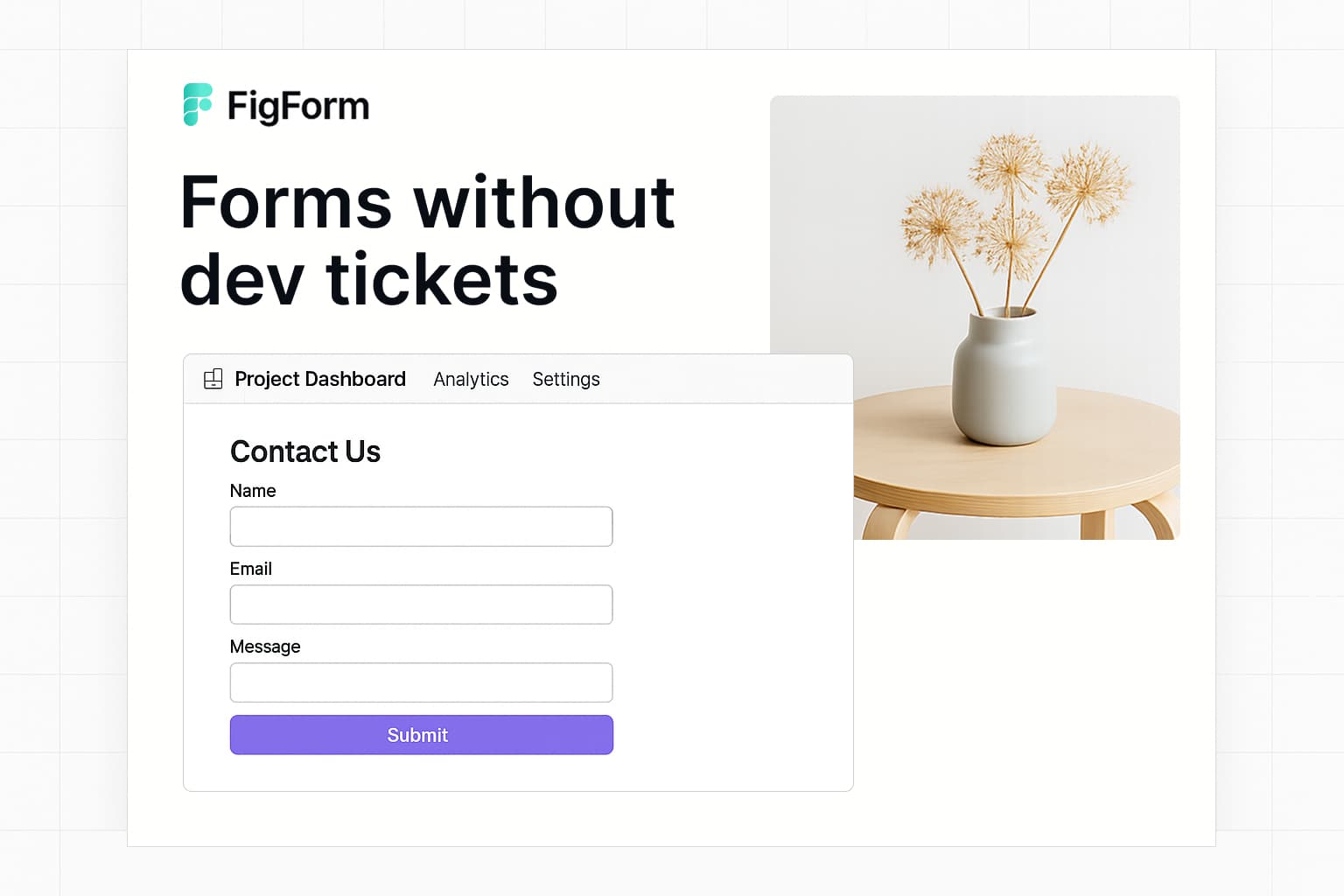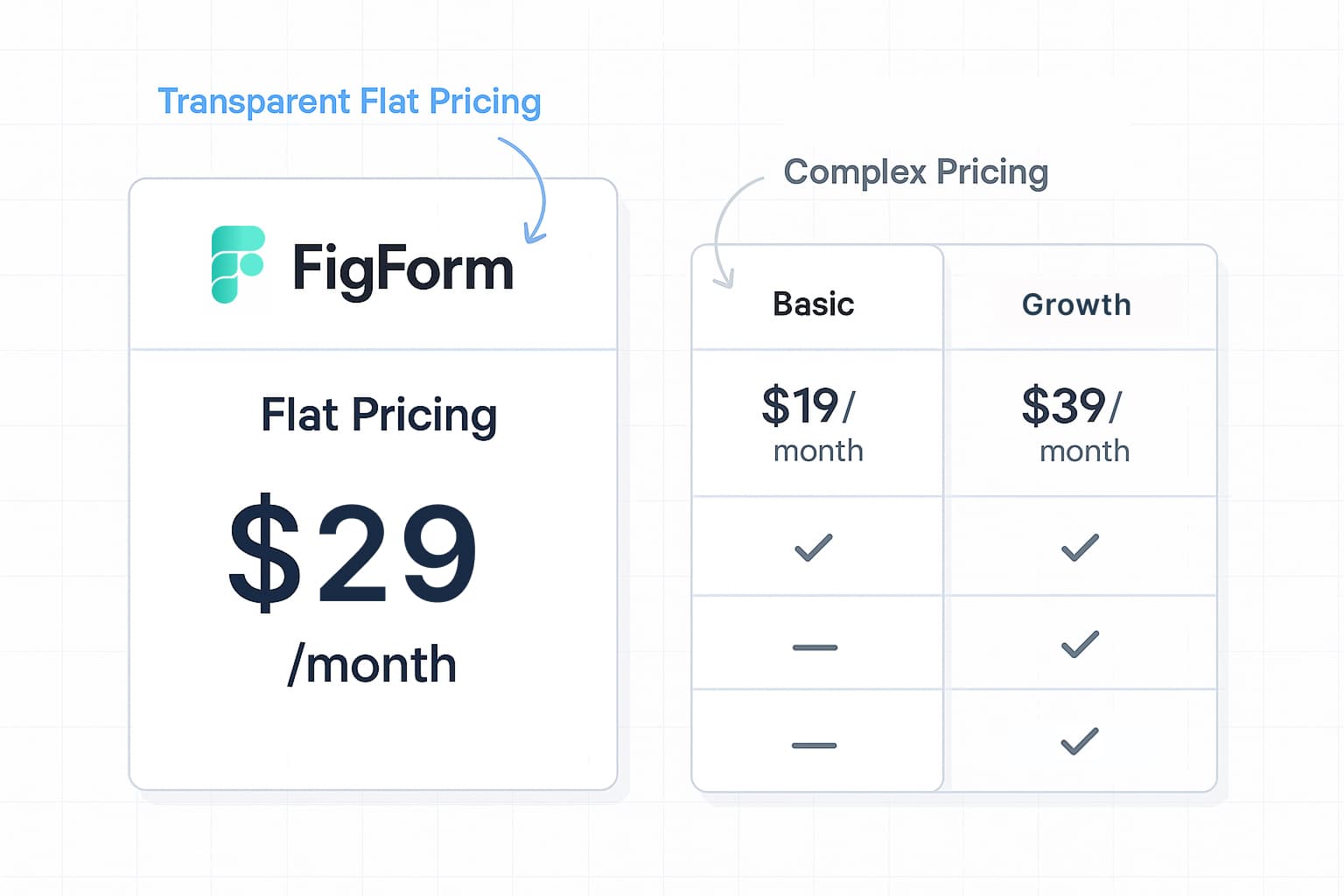
Why project managers need a different kind of form builder
If you run projects, you already run forms: intake, change requests, risk logs, UAT sign-offs, stakeholder feedback, vendor access, and more. The problem is never "Can we build a form?" - it's who builds it, how long it takes, and whether it looks like your brand.
FigForm gives PMs a no-code form builder that behaves like a Figma form builder - so you compose real, on-brand forms without borrowing engineering time or settling for generic UI. It's also a free form builder to start, so you can move now and standardize later.
What FigForm contributes to a PM's toolbelt
- Figma-style editor: Compose layouts visually - headlines, helper text, imagery, spacing - until the form feels native to your site or product.
- AI chat panel: Describe the job in plain language, the model proposes fields and copy you can refine live.
- Go-live, quickly: Add a single script line or use a hosted embed link to share.
- Simple analytics that matter: Visits, completed submissions, response rate - fast feedback to decide your next move.
- Automation via webhooks: Pipe results into Make, n8n, or Zapier for Slack alerts, tickets, CRM updates, and more.
- Operational clarity: Multiple workspaces, assign forms to specific clients, projects, or orgs.
- Data you control: Review in the UI, export CSV with field-level selection.

The PM Workflow: from request to go-live
Use this seven-step loop any time a form request lands on your plate.
Step 1: Clarify the decision this form enables
Capture "what decision needs better data?" (e.g. "Approve scope change", "Green-light launch", "Prioritize bugs").

Step 2: Draft the first version with AI
Open the AI chat panel and write a brief like:
"I need a concise change request form for mobile and desktop. Required: requester, impact summary, deadline. Optional: attachments. Tone: clear and professional".
The assistant proposes fields, labels, and helper text you can tighten quickly.

Step 3: Make it unmistakably on-brand
Apply your type scale, color tokens, spacing, and a small hero image or iconography. Your stakeholders should feel they never left your product.

Step 4: Publish without waiting on a sprint
Drop this single line where the form should render (replace FORM-ID):
Prefer a share-link for quick reviews? Use the hosted embed at https://figform.io/embed/FORM-ID.

Ready to design a form?
Start creating stunning forms using an intuitive Figma-like editor with a free account.
Start designingStep 5: Wire it to where work happens
Enable a webhook to Make, n8n, or Zapier. Typical PM flows:
- Notify a Slack channel on high-impact submissions.
- Create a ticket in Linear/Jira for bugs and scope changes.
- Append approved items to Notion/Sheets/CRM.

Step 6: Read signal, not dashboards
Start with three numbers: Visits, Completed, Response rate.
- Low visits: Fix placement or comms.
- Low response rate: Trim fields, clarify value, add trust cues.
- High completions: Automate the next step (assign, notify, schedule).
Step 7: Close the loop responsibly
Review responses in the UI. When sharing, export CSV with the exact fields stakeholders need - nothing more. Keep multi-client work clean with workspaces.

Project manager "SOP cards" you can roll out immediately
Below are lightweight patterns tailored to PM life. Each one includes fields, a handoff, and a "done" signal.
Kickoff intake
Use when: A project is approved and you need crisp inputs.
Fields: Sponsor, goals, constraints, dependencies, timelines.
Automation: Webhook → Create a Notion/Confluence brief + Slack #project-kickoff.
Success signal: Completion within 48 hours of approval.
Scope-change request
Use when: Stakeholders ask for "just one more thing."
Fields: Requester, change summary, impact areas (budget/schedule/risk), target date, priority.
Automation: Webhook → Linear/Jira "Change Request" ticket with labels.
Success signal: Decision recorded within 24 hours.
Risk log submission
Use when: Anyone can flag an emerging risk.
Fields: Risk description, likelihood, impact, owner, mitigation.
Automation: Webhook → Notion/Sheets "Risk Register" and Slack ping to #risk-watch.
Success signal: Owner assigned to 100% of new risks.
UAT sign-off
Use when: You need accountable acceptance before launch.
Fields: Feature area, environment, pass/fail, notes, attachments.
Automation: Webhook → Release checklist item marked complete. Slack to #go-live.
Success signal: 100% coverage of scoped features.
Incident report
Use when: Capturing facts during/after an incident.
Fields: Timestamp, impact summary, steps taken, suggested follow-ups.
Automation: Webhook → New "Post-mortem YYYY-MM-DD" page with appended entries.
Success signal: All incidents have at least three unique inputs within 24 hours.
Vendor access request
Use when: A partner needs temporary access.
Fields: Vendor name, access scope, duration, approver, compliance notes.
Automation: Webhook → Ticket to IT queue. Slack DM to approver.
Success signal: Approval or rejection within SLA.
Sprint demo RSVP + feedback
Use when: Gathering attendance and post-demo impressions.
Fields: RSVP (Yes/No), priorities seen, blocker comments.
Automation: Webhook → Calendar + a short feedback digest to #demo-recap.
Success signal: At least 60% stakeholder response rate.

Ready to design a form?
Start creating stunning forms using an intuitive Figma-like editor with a free account.
Start designingGovernance that scales with your book of work
Create multiple workspaces - one for each client, portfolio, or stream - and assign forms to them. Access is tidy, exports are scoped, and your PMO can audit who owns what.

What "simple analytics" means for projects
You don't need a BI tool to steer forms. FigForm surfaces the essentials:
- Visits show whether stakeholders actually see the form.
- Completed tells you if the ask is clear (and if friction is acceptable).
- Response rate helps you decide whether to adjust placement, copy, or fields.

Data flow without friction
- Webhooks connect to Make, n8n, or Zapier for instant handoffs into Slack, Linear/Jira, Notion, CRMs, or Sheets.
- Review in-app and export CSV with field-level control for share-outs and audits.

Plans made for delivery teams
- Free plan: unlimited forms and unlimited responses - ideal for pilots, PMO standards, and everyday use.
- Pro plan: access to smarter/bigger AI models in the chat panel with a transparent, flat monthly price - great for heavier drafting and refinement during peak seasons.

Ready to replace your ad-hoc forms with a repeatable system?
- Capture the decision and the audience.
- Draft with the AI chat panel.
- Apply brand in the Figma-style editor.
- Publish with one line or share the hosted embed.
- Route results with webhooks.
- Read visits/completed/response rate and iterate.
- Keep clients and projects clean with workspaces.
You'll move faster, keep everything on brand, and protect engineering time - using a form builder for project managers that feels familiar to design and friendly to operations.
Start on the free form builder plan and scale when you're ready - with the speed of a no-code form builder and the precision of a Figma form builder experience.